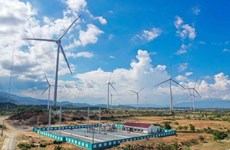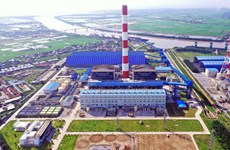Tourism sector clocks up growth, heralds new dynamics
Buoyed by the rapid growth of international tourist arrivals which have
risen to an all-time high with more than 7.57 million this year, the
local tourism industry targets around 8 million foreign visitors and 40
million domestic holidaymakers in 2014. Report by Nhan Dan Online.
Buoyed by the rapid growth of international tourist arrivals which have
risen to an all-time high with more than 7.57 million this year, the
local tourism industry targets around 8 million foreign visitors and 40
million domestic holidaymakers in 2014. Report by Nhan Dan Online.
Vietnam’s tourism sector achieved impressive progress in 2013, receiving 35 million domestic visitors and 7.5 million foreigners, an increase of 10.6 percent over the 2012, and earning total revenue of 195 trillion VND (9.17 billion USD). These figures show that the sector has recovered its growth rate and ensured that its development gets back on track.
Realising development goals
After four years of recovery from impact felt within the sector from the global economic recession of 2009, the number of foreign holidaymakers in Vietnam has doubled and the tourism revenue is 2.2 times higher. The sector has reached its 2015 targets, as set in the Strategy on Developing Vietnam’s Tourism, two years ahead of time.
The sector has benefited from improved infrastructure, and the transport system by air, roads and waterways has received ample investment to expand. The country has more than 14,200 lodgings, totalling 320,000 rooms, 34 percent of which are located in three-star to five-star hotels.
Tourism businesses and the 1,250 international travels agents operating in the country are providing customers with diversified products to penetrate new markets. People working in the field, directly and indirectly, are of increasing quality and professionalism.
Last year also saw the establishment of new tourist facilities; cultural, sporting and entertainment sites; fairs; exhibitions and related services, as well as a series of four-star and five-star hotels and resorts, all of which contributes to the significant overhaul of the hospitality sector.
These spectacular achievements have illustrated the clear-sighted recent guidelines on tourism development set by the Party, State and Government with the aim of turning the sector into a key industry. Favourable conditions, including the high appreciation of foreign visitors to Vietnam, have also contributed to the progress. Plus, abundant natural resources help to create diversified and unique tourist products.
Difficulties and challenges
At the beginning of the year, the number of visitors to Vietnam slumped slightly, leading those working in the field to taking a frank look at their limitations. They found that shortcomings in the sector’s operation include weak management, poor sanitary conditions, disorder and unsafe conditions at tourist attractions, and more cases of tourists being cheated during the high season.
The overexploitation of tourist resources has damaged the natural environment, while the work of environmental and social management has not received enough attention from authorities.
Climate change has recently led to an irregularly high occurrence of natural disasters, including storms and floods, which have had negative impacts on tourist infrastructure and tourist programmes in affected localities.
A lack of professionalism in tourism product creation marketing, coupled with a dearth of well-qualified workers in the field has imposed limitations on the sector’s viability. As the State budget spent on hospitality in Vietnam is less than in other countries in the region, the sector has achieved modest results in advertising Vietnam’s attractions and stimulating tourist demand in targeted markets.
Moreover, the co-ordination between the tourism sector and relevant industries, as well as that among localities, has not worked effectively. The inactivity of local tourist businesses in developing markets, creating distinguished products and improving quality has combined with the industry’s unhealthy competiveness to cause serious consequences for Vietnam’s image.
Meanwhile, the national tourism industry is undergoing increasing pressures of product price, staff quality and service, and business capacity from other countries in the region. Vietnam has to vie with top tourist attractions in the region – including Malaysia, Thailand and Singapore – which have made massive investments in their hospitality sectors to enhance staff qualifications and update tourist products.
As the ASEAN nations are set to cut their non-tariff barriers to 0-5 percent after 2015, Vietnam must make good preparations to protect the market share of Vietnamese tourist businesses, both domestically and internationally.
Solutions for short-term and long-term development
Considering the current domestic and international situation, Vietnam’s tourism sector has followed the guidelines set in the Strategy and Master Plan of Tourism Development by 2020, with a vision towards 2030.
In 2014, the sector will focus on realising the Government instruction on ensuring the health, safety and security of visitors. One of the urgent goals under this category is to build hygienic public toilets at all tourist sites.
It is necessary to have a law enforcement agency responsible for ensuring security and ensuring a healthy environment for visitors as many countries with strong tourism brands already do. Vietnam should also establish the Tourism Police, particularly in major cities and tourism centres that attract many tourists.
In the long term, the sector should prioritise reforming and perfecting policies, mechanisms and laws relating to tourism to pave the way for its development and foster market research and tourism promotion, as set out in the Plan on Building Vietnam Tourism Brand by the Vietnam National Administration of Tourism.
The sector should focus on attracting more domestic visitors, particularly when the number of foreign visitors decreases due to external reasons.
In addition to consolidating discipline in the operation of travel agents and removing unregistered ones, the sector ought to create favourable conditions for tourism businesses to improve their performance and increase their competitiveness as Vietnam becomes more strongly integrated in international institutions.
The Ministry of Culture, Sports and Tourism has proposed solutions to the Government for developing tourism in the 2013-2014 period and creating momentum for the development of related industries. It has also suggested preferential policies for businesses working in the field and simpler administrative procedures for foreign visitors to Vietnam.
The hospitality sector is set to become a key industry with professionalism, modern infrastructure, high-quality products, established trademarks, and a high standard of competitiveness against the tourism industries of countries in the region and the world.
Promoting its achievements in 2013, it is expected that the hospitality sector will continue to create momentum for its robust development in a bid to achieve its 2014 target of attracting 48 million visitors, including 8 million foreigners, and earning 220 trillion VND (10.34 billion USD) in total revenue.-VNA
Vietnam’s tourism sector achieved impressive progress in 2013, receiving 35 million domestic visitors and 7.5 million foreigners, an increase of 10.6 percent over the 2012, and earning total revenue of 195 trillion VND (9.17 billion USD). These figures show that the sector has recovered its growth rate and ensured that its development gets back on track.
Realising development goals
After four years of recovery from impact felt within the sector from the global economic recession of 2009, the number of foreign holidaymakers in Vietnam has doubled and the tourism revenue is 2.2 times higher. The sector has reached its 2015 targets, as set in the Strategy on Developing Vietnam’s Tourism, two years ahead of time.
The sector has benefited from improved infrastructure, and the transport system by air, roads and waterways has received ample investment to expand. The country has more than 14,200 lodgings, totalling 320,000 rooms, 34 percent of which are located in three-star to five-star hotels.
Tourism businesses and the 1,250 international travels agents operating in the country are providing customers with diversified products to penetrate new markets. People working in the field, directly and indirectly, are of increasing quality and professionalism.
Last year also saw the establishment of new tourist facilities; cultural, sporting and entertainment sites; fairs; exhibitions and related services, as well as a series of four-star and five-star hotels and resorts, all of which contributes to the significant overhaul of the hospitality sector.
These spectacular achievements have illustrated the clear-sighted recent guidelines on tourism development set by the Party, State and Government with the aim of turning the sector into a key industry. Favourable conditions, including the high appreciation of foreign visitors to Vietnam, have also contributed to the progress. Plus, abundant natural resources help to create diversified and unique tourist products.
Difficulties and challenges
At the beginning of the year, the number of visitors to Vietnam slumped slightly, leading those working in the field to taking a frank look at their limitations. They found that shortcomings in the sector’s operation include weak management, poor sanitary conditions, disorder and unsafe conditions at tourist attractions, and more cases of tourists being cheated during the high season.
The overexploitation of tourist resources has damaged the natural environment, while the work of environmental and social management has not received enough attention from authorities.
Climate change has recently led to an irregularly high occurrence of natural disasters, including storms and floods, which have had negative impacts on tourist infrastructure and tourist programmes in affected localities.
A lack of professionalism in tourism product creation marketing, coupled with a dearth of well-qualified workers in the field has imposed limitations on the sector’s viability. As the State budget spent on hospitality in Vietnam is less than in other countries in the region, the sector has achieved modest results in advertising Vietnam’s attractions and stimulating tourist demand in targeted markets.
Moreover, the co-ordination between the tourism sector and relevant industries, as well as that among localities, has not worked effectively. The inactivity of local tourist businesses in developing markets, creating distinguished products and improving quality has combined with the industry’s unhealthy competiveness to cause serious consequences for Vietnam’s image.
Meanwhile, the national tourism industry is undergoing increasing pressures of product price, staff quality and service, and business capacity from other countries in the region. Vietnam has to vie with top tourist attractions in the region – including Malaysia, Thailand and Singapore – which have made massive investments in their hospitality sectors to enhance staff qualifications and update tourist products.
As the ASEAN nations are set to cut their non-tariff barriers to 0-5 percent after 2015, Vietnam must make good preparations to protect the market share of Vietnamese tourist businesses, both domestically and internationally.
Solutions for short-term and long-term development
Considering the current domestic and international situation, Vietnam’s tourism sector has followed the guidelines set in the Strategy and Master Plan of Tourism Development by 2020, with a vision towards 2030.
In 2014, the sector will focus on realising the Government instruction on ensuring the health, safety and security of visitors. One of the urgent goals under this category is to build hygienic public toilets at all tourist sites.
It is necessary to have a law enforcement agency responsible for ensuring security and ensuring a healthy environment for visitors as many countries with strong tourism brands already do. Vietnam should also establish the Tourism Police, particularly in major cities and tourism centres that attract many tourists.
In the long term, the sector should prioritise reforming and perfecting policies, mechanisms and laws relating to tourism to pave the way for its development and foster market research and tourism promotion, as set out in the Plan on Building Vietnam Tourism Brand by the Vietnam National Administration of Tourism.
The sector should focus on attracting more domestic visitors, particularly when the number of foreign visitors decreases due to external reasons.
In addition to consolidating discipline in the operation of travel agents and removing unregistered ones, the sector ought to create favourable conditions for tourism businesses to improve their performance and increase their competitiveness as Vietnam becomes more strongly integrated in international institutions.
The Ministry of Culture, Sports and Tourism has proposed solutions to the Government for developing tourism in the 2013-2014 period and creating momentum for the development of related industries. It has also suggested preferential policies for businesses working in the field and simpler administrative procedures for foreign visitors to Vietnam.
The hospitality sector is set to become a key industry with professionalism, modern infrastructure, high-quality products, established trademarks, and a high standard of competitiveness against the tourism industries of countries in the region and the world.
Promoting its achievements in 2013, it is expected that the hospitality sector will continue to create momentum for its robust development in a bid to achieve its 2014 target of attracting 48 million visitors, including 8 million foreigners, and earning 220 trillion VND (10.34 billion USD) in total revenue.-VNA











